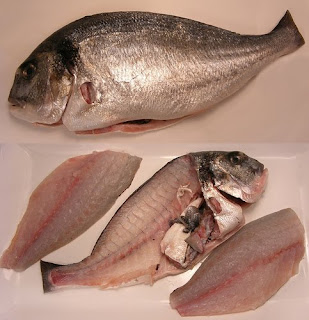Good morning Chefs and Buyers,
Hope everyone had a great weekend. There is still some problems with flights out of Northern Europe because of volcanic ash that have left us short on a few items like Dover sole, and we are still waiting to see if we can get product on a flight later this week. Spain and Portugal are so far unaffected so sardines have landed and are available today.
Arriving this morning we have some great fish from our guys in Apalachicola, Florida. Crispy fresh 16/20 shrimp tails, metallic silver and graphite colored Spanish mackerel, domestic red grouper, and large American red snappers with candy red gills are all just in today and ready for you to appreciate.
We have fresh frog legs in today, they flew out the door last time, so order early before they are sold out again. Razor clams and live sea scallops in the shell are also available, both items are fresh and full of vigor and ready to impress your guests.
Local specials include whitebait / eperlan, black sea bass, wild Delaware striped bass, fresh fancy fluke, and bright local squid.
| "If we were logical, the future would be bleak, indeed. But we are more than logical. We are human beings, and we have faith, and we have hope, and we can work." ~Jacques Cousteau Good day,
Popular posts from this blog

I often find it necessary to explain the yield (amount of usable flesh) off of various fish. By knowing what percentage of meat will be available when a whole fish is filleted one can make an accurate analysis of; A. how much whole fish must be purchased and B. what is the true fillet cost. Knowing how to correctly perform these calculations will benefit not only seafood suppliers, restaurant chefs, but also the casual cook. Below is a list of some common fish and the net yield percentages. Actual percentages may vary depending on skill of the butcher. Salmon (head-on gutted) yields 75% skin-on fillet Snapper (head-on gutted) yields 40% skin-on fillet Mahi (headed and gutted) yields 65% skin-on fillet Monkfish (tail) yields 70% skinless fillet Cod (headed and gutted) yields 60% skin-on fillet Grouper (head-on gutted) yields 35% skinless fillet Halibut (headed and gutted) yields 66% skin-on fillet Tuna (headless bullets) yields 75% untrimmed loins Sword (headless bullets) yields 80% cen...
Ever wonder what the differences are between Sole and Flounder? Some customers recently asked me the question so I thought I would take a moment to shed a bit of light on the subject. Here in North America we have no true sole only flounders. When Europeans came to the Americas they called flounders soles because they looked like the fish they knew in the "old world". This has led understandably to much confusion over the years. The only true sole would be Dover Sole, Solea solea . Lemon sole is one of the names given to winter flounder, Pseudopleuronectes americanus , (also known as black back). Usually at the retail level when multiple flounder sku's are sold; flounder is the name given to the refreshed less expensive product, and sole (or lemon sole) is the name given to the more expensive fresh cut product. Fluke, Paralichthys dentatus also called summer flounder can also be sold as sole fillet. Sometimes there is a distinction ...
Top Catch Timed Caught in Time Frozen portioned in same format as TBD. Matt Hovey Have fish, will travel 727-504-3819
|


Comments